Social influence and social change
1/19
There's no tags or description
Looks like no tags are added yet.
Name | Mastery | Learn | Test | Matching | Spaced |
|---|
No study sessions yet.
20 Terms
social change
when a view held by a minority group challenges the majority view and is eventually accepted by the majority. Then, whole societies (not just individuals) adopt new attitudes, beliefs or behaviours
More likely to occur when minority groups show consistency, flexibility and commitment in their views (snowball effect)
Obedience and social change
members of the government are a minority group that can enact dramatic social change by creating laws. When laws are created, societies change to avoid punishment. E.g. making smoking in public places like pubs illegal, anti-discrimination laws and regulating behaviour during a pandemic
Conformity and social change
NSI/compliance = behaviours or views can become the norm without a minority group, such as recycling, vaping, or fitness in young people; those who go against this norm risk rejection. The norm can then spread to the broader society
ISI/internalisation = members of a minority group can provide information to the majority, such as the effects of climate change. Wider society changes its behaviour because it accepts this new evidence
Social crypto-amnesia
describes how society adopts ideas from a minority group; however, once the mainstream accepts these ideas and they become the norm, the sacrifices made by the minority group in initiating these positive social changes are not acknowledged but are forgotten over time
ways social change can happen
minority or majority influence
how does minority influence lead to social change
members of a majority group change their beliefs or behaviours as a result of their exposure to a persuasive minority
how does majority influence lead to social change
if people perceive something to be the norm, they tend to alter their behaviour to fit that norm
appeals to NSI
e.g. reducing litter by printing normative messages on litter bins (bin it - others do)
list of processes that lead to social change
consistency
deeper processing
drawing attention
the Augmentation Principle
The Snowball Effect
Social cryptoamnesia
NSI
Gradual commitment

(7 marks)


(4 marks)


(6 marks)

consistency and social change
a consistent message appears more credible and help convince a majority
deeper processing
the more people think about the issue at hand, rather than blindly accepting it, the more they will be able to challenge the existing social norms and bring about change
drawing attention
majority must firstly be aware for change to happen
gradual commitment
once a small instruction has been followed, it is harder to decline a larger request.
‘the foot in the door technique’
people find themselves adopting a new way of behaving gradually over a period of time
Nolan et al. (2008) + counterpoint
P: Research support for NSI in bringing about social change
E: Investigated whether social influence processes led to a reduction in energy consumption in a community. They hung messages on the front doors of houses in California every week for one month. The key message was that most residents were trying to reduce their energy usage. As a control, some residents had a different message that just asked them to save energy but made no reference to other people’s behaviour. They found significant decreases in energy usage in the first group.
C: Shows conformity can lead to social change through the operation of NSI
COUNTERPOINT
P: Some studies show that people’s behaviour is not always changed through exposing them to social norms
E: Foxcroft et al. (2015) reviewed social norms interventions as part of the ‘gold standard’ Cochrane Collaboration. This review included 70 studies where the social norms approach was used to reduce student alcohol use. They found only a small reduction in drinking quantity and no effect on drinking frequency
C: Shows using NS does not always produce long term social change
Linkenbach and Perkins (2003)
P: US research that shows the relationship between people’s normative beliefs and social change (the likelihood of them stopping smoking).
E: In a campaign aimed at 12-17 year olds in 7 counties in Montana, USA, they found that adolescents exposed to the simple message that the majority of their age peers did not smoke were subsequently less likely to take up smoking.
C: The social change that occurred in young adults within Montana can be attributed to NSI as individuals conform in order to be accepted and fit in with a group (in this case: peers of the same age)
Nemeth (2009)
P: Psychologists can explain how minority influence brings about social change
E: Nemeth claims social change is due to the type of thinking that minorities inspire. When people consider minority arguments, they engage in divergent thinking. This is a broad way of thinking, in which the thinker actively searches for information and weighs up more options. They argued this leads to better decisions and more creative solutions to social issues
C: Shows why dissenting minorities are valuable - they stimulate new ideas and open minds in a way majorities cannot
Mackie (1987)
P: A limitation is deeper processing may not play a role in how minorities bring about social change
E: Some are supposedly converted because they think more deeply about the minority’s views. Mackie disagrees and presents evidence that it is majority influence that may create deeper processing if you do not share their views. This is because we like to believe that other people share our views and think the same way as us. When we find that a majority believes something different, we are then forced to think about their arguments and reasoning.
E: Means the central element of minority influence has been challenged, casting doubt on its validity as an explanation of social change
Issues and debates
reports of social change cannot be tested empirically so lacks scientific credibility. So an idiographic approach is usually taken as there is lots of subjective interpretation